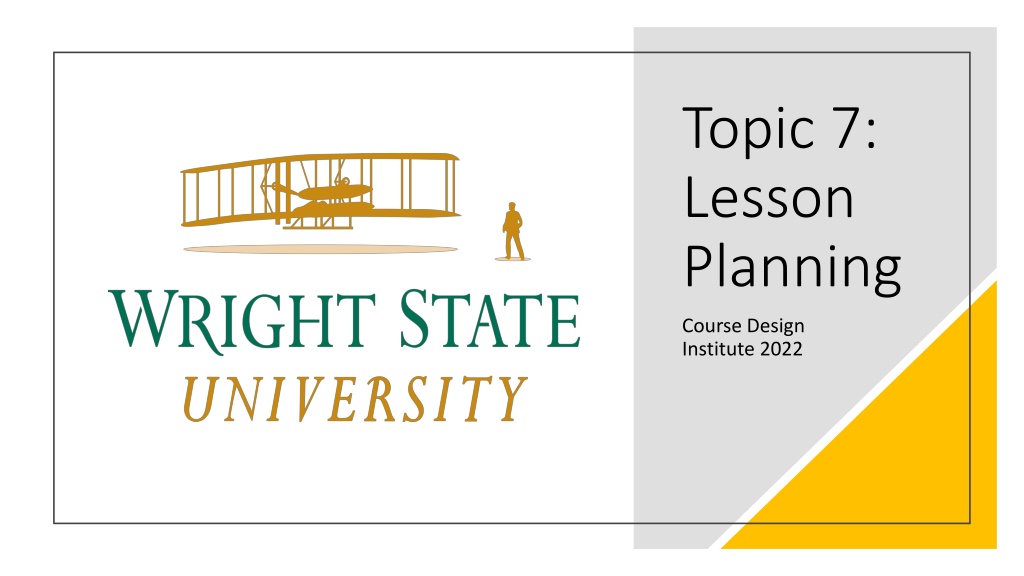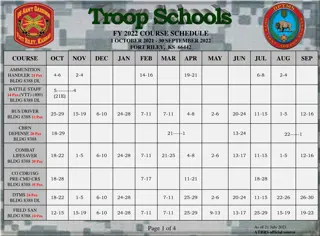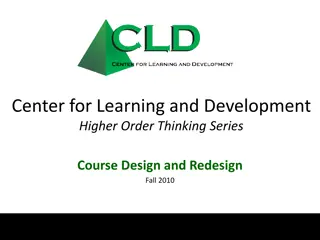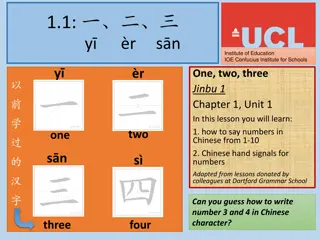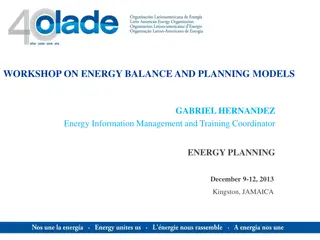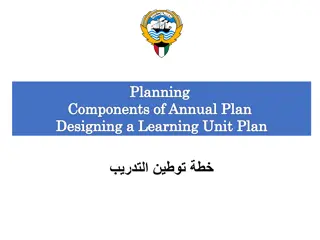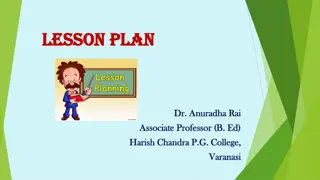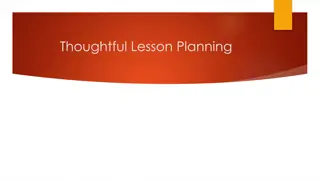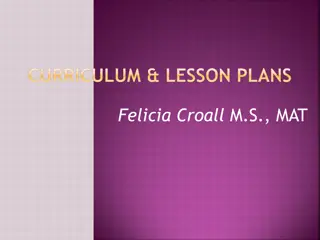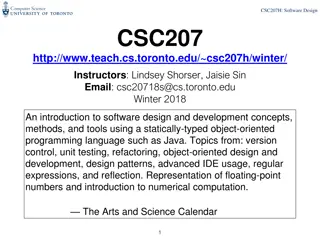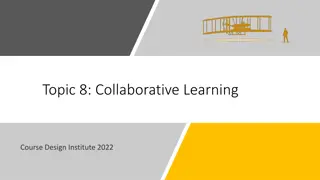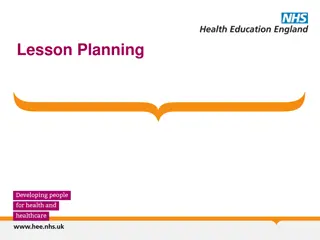Topic 7: Lesson Planning. Course Design Institute 2022
Engage in effective lesson planning practices to enhance teaching effectiveness in higher education. Understand the importance of lesson plans and considerations for instruction design for optimized student learning outcomes. Explore lesson elements and objectives to create engaging and purposeful class sessions.
Download Presentation

Please find below an Image/Link to download the presentation.
The content on the website is provided AS IS for your information and personal use only. It may not be sold, licensed, or shared on other websites without obtaining consent from the author. Download presentation by click this link. If you encounter any issues during the download, it is possible that the publisher has removed the file from their server.
E N D
Presentation Transcript
Topic 7: Lesson Planning Course Design Institute 2022
Pop Quiz! Question: What is the first thing you think of when you hear the phrase lesson plans ? Answer Options (choose all that apply): A. Uncommon in higher education B. Only K-12 teachers are required to do them C. A good strategy for keeping instruction on track and aligned with outcomes and objectives D. Limit serendipitous teaching opportunities E. Other ____________________________
Lesson Plans As the result of our course development activities, you ve determined what your students must know and do during the course you re planning and how you will measure their acquisition of this knowledge and skill. Now, we turn our attention to what we, as teachers, will do during each class session. This, too, begins with planning. It s true that formal lesson plans are not mandatory in higher education, but they re still good pedagogical practice. Crafting a lesson requires thoughtful preparation resulting from operative knowledge of good teaching. It s likely you ve already addressed these key considerations while you completed the overall design of your course, but they apply equally to the plan for an individual lesson as they do to the map of the entire progression of study.
Considerations for Instruction Rationale and Objective: what s the point of the planned instruction? In other words, why is it important, how will you convey these ideas to your students, and what do you expect your students to know and be able to do after they ve received this instruction? Instructional Context: how does the planned instruction fit into the overall design of the course? Learner Support: what common student misconceptions or errors can you anticipate and how will you address them? Enrichment: how might you extend student learning or challenge higher achievers? Assessment: how will you know if your students have learned what you taught them during the class session?
Lesson Elements Objective Hook that grabs the students attention Teaching: Lecture Discussion Demonstration Active student participation Guided practice and checking for understanding Independent practice Assessment
Objective: Whats the point? Each lesson has a unique objective. In other words, what s the point of what you re teaching? What should students know and be able to do by the end of the lesson? Even if it s strictly for your own reference, it s helpful to create an outline of the major points you want to address in each lesson. Consider providing these outlines to your students, which frees them to participate actively rather than frantically taking notes. An outline also serves to keep the day s instruction on track. The lesson objective can be stated on the outline or course notes, and it should clearly relate to the outcomes and objectives statements for the course, as stated on the syllabus. Remember EVERY lesson and EVERY assignment and EVERY assessment should clearly and specifically relate to the outcomes and objectives of the course, and these should be evident on the course syllabus. The lesson outline should also include key vocabulary terms and definitions appropriate to the day s discussion. It s essential for faculty to teach students the language of the discipline systematically to be successful in the course.
Hook Hook Examples alarming statistics interesting fact (related trivia) story or anecdote personal experience literature exaggeration image, artwork, map, or other visual element audio recording/media clip graphic organizer (Venn diagram, concept web) questions example artifact riddle, joke, or funny anecdote An excellent lesson begins with a hook that captures the students attention. TED speakers regularly use this technique. The hook should only take the first 5 minutes of class. Distributing copies of the lesson outline does NOT count as a hook, nor does saying, Okay, Class, today we re going to talk about ________. If you re continuing a discussion from a previous lesson, you can just remind students of where you left off and then proceed. BUT, if you re presenting something new, a hook is in order.
Instructional Delivery Once you have your students attention, you can begin instruction. Instructional activities can include, but are not limited to: Lecture Discussion Demonstration, Active student participation Project-based learning A combination of these and other approaches. (In-depth discussion of such pedagogical activities will be provided in subsequent presentations.)
Empowering Student Success Most faculty have encountered situations where we notice that our students display misconceptions or lack basic disciplinary knowledge, hampering their ability to learn what we re trying to teach. Therefore, we must systematically and deliberately teach these fundamentals regardless of whether we believe that students should already possess this basic knowledge. We also need to deliver direct instruction in necessary skills, providing concrete examples and incorporating opportunities for students to practice these new skills before expecting them to perform at a level of mastery. This may necessitate building additional lessons into your syllabus beyond the specific content you intend to cover such as: Essential vocabulary Instruction in new or foundational skills Instruction in appropriate behavior during presentations, performances, or critique
Guided Practice It s usually not enough to simply tell students how to do something. We need to provide direct, systematic, concrete instruction for everything we expect students to know or be able to do. This is sometimes called scaffolding. Demonstrate: direct instruction using models and examples of the skill students must acquire. Facilitate: guided activity, often in a group setting, involving supported student practice of the skill. Evaluate: independent practice of the skill, assessed separately from a content-area assignment.
Example: Developing Skill in Critical Analysis Demonstrate: the professor explains how to write film criticism by providing step-by-step directions, examples of professional criticism, and specific criteria. Facilitate: the professor divides the class into small groups, giving each group a different prompt along with step-by- step directions. The professor walks around the room, helping groups as they work together to complete the task. At the end of the allotted time, groups share their analyses with the class, while the professor provides commentary and critique. Evaluate: the professor assigns students to choose a film they ve seen before and write their own criticism. Because this is a formative assignment, it has a low point value and is graded only on student s demonstration of skill rather than the broader criteria that will apply to later assignments.
Mnemonics A simple way to understand how to scaffold instruction is : Walk through: walk students through the skill by demonstrating how to do what you expect them to do (demonstrate) Talk through: guide students as they practice the skill together under your supervision (facilitate) Drive through: students practice independently (evaluate) Scaffolding is sometimes also shortened to: I do (demonstrate) We do (facilitate) You do (evaluate)
Check for Understanding It s not enough to simply ask, Any questions? at the end of the lecture. A student who s confused won t usually speak up. A better method is to use an exit slip: a half-sheet or quarter- sheet of paper containing one or two questions that students must answer prior to leaving the classroom. Posting the question to the LMS is also an effective strategy. You don t have to grade students answers (although you do have to read them), but they give each student the chance to show what they know or don t know, guiding subsequent instruction.
Independent Practice Homework, assignments, and projects are opportunities for students to independently practice what they learned in class. Make sure that the tasks students must do outside of the classroom: Relate to what was taught in that class session Support one or more of the course objectives Are within students ability to accomplish independently
Assessment An exit slip or homework assignment provides formative assessment of the lesson s objective. Observation of students participation during the guided learning portion of class provides further opportunities to assess their learning. Sometimes an assessment or assignment encompasses several lessons. Although these are usually summative, taking a more formative approach by allowing students to make corrections and re-submit sub-standard work for a better grade can improve their learning, raise their course grades, and encourage persistence.
Big Picture Review Program Outcomes, Objectives, and Assessment Course Outcomes, Objectives, and Assessment Mission and Accreditation Requirements Plan Instruction (course schedule and map) Create or Gather Instructional Materials Assess the Course and Reflect Revise, Improve, and Teach Again Teach the Course
Your Turn Use the Topic 7 Worksheet: Lesson Plan Template to create a lesson plan for the course you re designing or for a different course you re presently teaching. (10 min.) Discuss your lesson plan with someone near you, focusing on how to implement the plan in your classrooms. (5 min.)
